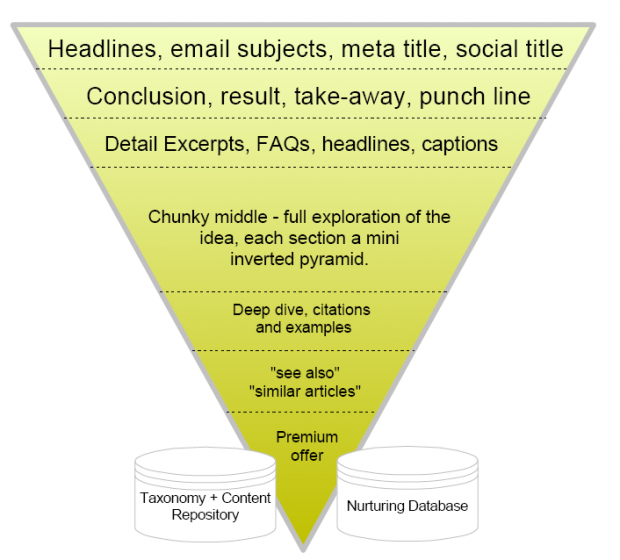When blogging for a hurried, distracted audience, you must keep in mind that the competition for attention is ruthless. More distraction, mobile device habits and shorter attention spans force us to adapt our inbound techniques accordingly, hoping to hold onto even a small fraction of fleeting consumers. New bloggers frequently write from the old-fashioned research paper or book report format saving conclusions and critical points to well after the reader has departed.
I firmly believe that adopting an extended inverted pyramid can drive more engagement, brand awareness, social shares and SEO. Extending it slightly to tap into your content repository and segmented markets, you can also set up long term engagement opportunities. Many, surprisingly, are resistant to the needed change – perhaps the new style is alien to them, or perhaps they just don’t want to admit that people are not interested enough to finish a lengthy article to get to the main point.
The Linked and Extended Inverted Pyramid

Encouraging Down-Linking Within the Top 20% (aka the Linked Inverted Pyramid approach)
The Inverted Pyramid blogging style, originating in printed newspapers where the editor must have freedom to cut a story off anywhere, has long been a writing approach that facilitates the 80/ 20 rule where 80% of readers will only see 20% of the content.
What’s essential to leveraging this dynamic is to hyperlink content within the 20% to pull readers deeper down the post into areas of particular interest. This adds click targets for the reader which both educate (what’s further down) and facilitate (clicks) while they are skimming. This behavior can drive dwell time and additional clicks to more content, including gated, lead generated content. If you don’t get the reader to take those off-ramps (anchor hyperlinks) at the top 10% of the pyramid, the rest of the content will go unread.
Some believe that for some blogs, readers are getting further into a post than the 80/20 rule might indicate. I think that this comes with reputation, so Slate magazine, cited in this data and used by some as evidence against the inverted style’s 80/20 roots, may well get more visitors deeper into more posts – they write kick-ass content regularly. If, as this data suggests, 2/3 of the time people spend time below the fold, it’s essential that you introduce eye fixation, compelling headlines and more to draw the user “back in” to the content after the scrolling is done.
Social Network Sharing and the Pyramid
 In social networks where the posts are shared you are given a very limited ability to capture the reader’s attention – with headline description and image provided from the open graph markup in your content tool. Email marketers, in my experience, seem to keep forgetting the power of the subject and excerpt-lines for most in-boxes, also preventing people from entering. Social shares can also occur as a result of only a great headline and skimmable excerpt, even if, parish the thought, the reader never read what they shared.
In social networks where the posts are shared you are given a very limited ability to capture the reader’s attention – with headline description and image provided from the open graph markup in your content tool. Email marketers, in my experience, seem to keep forgetting the power of the subject and excerpt-lines for most in-boxes, also preventing people from entering. Social shares can also occur as a result of only a great headline and skimmable excerpt, even if, parish the thought, the reader never read what they shared.
When do people decide to share an article with a social network? This is tough. Some readers share after only skimming the headline, while others think deeply before pushing it out. I’ve not seen any comprehensive information on this, but a few good articles have discussed it. I think that introducing share-suggestions at different points in the articles can help you determine what works for your site.
For SEO, the inverted pyramid style is ideal, giving algorithms what the need above the fold and early in the indexing process. Thinking in an inverted style means you must create good headlines, good excerpts and thematic and supporting headlines and captions – if you introduce keywords relevant to your article, this drill-down approach aligns with best practices for SEO.
Taxonomy Supports the Deep Dive (and Future Engagement Opportunities)
As the reader makes their way deeper into the content, they’ve invested more into your topic, and they are primed for an introduction to topically similar content, even premium content delivered in a lead nurturing program or re-marketing response. A solid taxonomy for your content collection allows you to quickly call for lists of similar content by tag and a database of solid premium research or other material in exchange for contact information gives you permission to provided segmented material to this reader in the future.
building photo by laurenmanning/flickr (cc) used under creative commons







